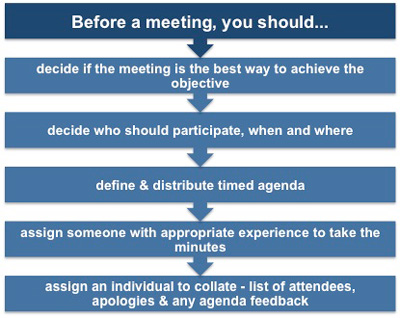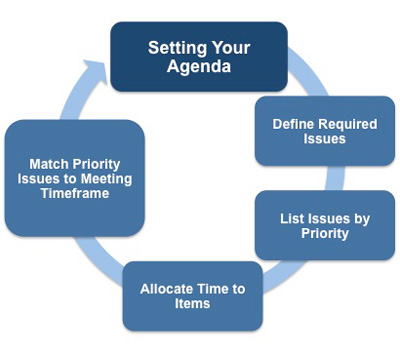Chairing a Meeting - Your Responsibilities Before the Meeting Begins
As Chair, you need to be aware that your duties are not solely confined to that of the meeting itself.
When asked to perform the role of Chair you need to be conscious of the tasks you must perform before the meeting. You may choose to delegate some of them - for example, circulating the agenda and coordinating attendee acceptances.
 |
As Chair, you need to be sure that a meeting is the best way to achieve the objective and that you have asked the 'right' people to attend. You need to acquire sufficient knowledge of the issues you have been asked to address through the meeting objective so that your request for attendees will be seriously considered.
When drawing up a list of people to invite you need to be certain that they have the right skills, knowledge, and authority to make the decisions required. Your invite to them needs to communicate the meeting objective clearly and outline the importance of their own contribution, expertise, and participation, so that they see the meeting as worth attending.
You are not pre-empting the meeting outcome with this activity; your objective is to gain everyone's 'buy-in' to the meeting. This may involve you in some personal networking with key individuals to properly apprise them of the situation and its importance.
As a manager it will usually be appropriate for you to delegate to a member of your team the co-ordination of attendees' replies. This person will collate the final list of attendees, which will be supplied to the minute taker prior to the meeting.
A key factor that can influence people's attendance at a meeting is its time and location. This issue will largely be dictated by circumstances, as you may not have the freedom to select the ideal date and location of the meeting. In the case of tight deadlines these factors are decided on practical terms rather than those that would ensure the most attendees.
If you find yourself in the situation where a critical number of key individuals are unable to attend the meeting do not be afraid to postpone or cancel it. Trying to proceed without the right people is usually a waste of time.
Creating an agenda follows a simple three-stage process.
 |
Firstly, use your knowledge of the situation to list the key issues requiring discussion and resolution. Then for each item give it a weighting in terms of its significance to achieving the objective, and allocate a period of time you think is necessary to discuss it. Finally, put these items into your meeting timeframe using the weighting as a means of prioritizing items. Your resulting agenda will cover all the key items with sufficient time to discuss each one.
Your final action before the meeting is to allocate someone to take the minutes. They should have sufficient knowledge of the subject under discussion that they are able to take accurate notes, as well as recognize key facts and decisions. If this person also has a contribution to make at the meeting, then you need to agree with them in advance who is qualified to take notes on their behalf whilst they contribute to the meeting.
This Meeting Agenda Checklist outlines the five key areas you need to address to produce an effective agenda. This Meeting Attendee List Template provides you with a sheet to record everyone who needs to receive copies of meetings minutes. This Meeting Action List Template enables you to record actions, responsibilities and timescales that result from the meeting.
Whoever you choose to take the minutes at your meeting must be aware of what is required. You may want to ensure that several of your team members are competent in this area so that they can be called on to perform this role. Many managers use a simple rotation of who takes the minutes at their own team meetings.
The tasks listed here represent what is usually expected of a Chair, but you should assess your own requirements and act accordingly.
You may also be interested in:
Chairing a Meeting | The Skills Required to Chair a Meeting | Meeting Rules | How to Begin the Meeting | Chairperson's Responsibilities During the Meeting | Chairperson's Responsibilities After the Meeting.



